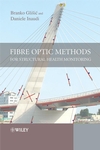
The St. Anthony Falls Bridge is already under the microscope as construction continues at breakneck speed to replace the collapsed I-35W bridge—and it’s already pushing new boundaries in intelligent design. But by turning the lens on itself, America’s smartest bridge could have an even bigger impact.
A new high-tech structural health monitoring system equipped with 240 sensors should inform how we monitor other bridges and, eventually, determine how we build them. For all the details and an exclusive animation of the accelerometer-laden fiber-optic rig, we sat down with Figg Engineer Group CEO Linda Figg, who’s heading up St. Anthony Falls' design, before she appeared at the PM-NSF Bridge to the Future summit today.
Some details of the sensing system have been ironed out, but most are being determined as the bridge goes up—much like its entire design and construction, which occurred almost simultaneously. The importance of the sensors, Figg insisted, is that all the information they collect will funnel into a database, eventually helping other engineers determine how best to design and build a bridge.
To round up that data, the system—a collaboration between the University of Minnesota and the Minnesota Department of Transportation—will employ at least four different kinds of sensors: accelerometers (red), chloride penetration sensors (magenta), linear potentiometers (blue) and wire strain gauges (green). "The accelerometers will measure vertical deflections [or deformation] with traffic loads," Figg said. The chloride penetrating sensors will evaluate the condition of surface wear and tear by measuring whether or not salt is penetrating the pavement on the bridge deck. Repair and replacement are pricey, so early monitoring should make up for the initial cost of the sensors.
Meanwhile, linear potentiometers will measure pressure to keep track of St. Anthony Falls’ expansion joints and bearings; Figg said UMinn and Mn/DOT would correlate that data with design codes to analyze how the bridge performs over its lifespan. Finally, the wire strain gauges will measure temperature as well as the amount of force per sq. in. placed on the concrete—all important in assessing a bridge's condition.
The four sensors will be hardwired using fiber optics through the bridge, then wirelessly transmitted for analysis. They will account for about 100 of the sensors on the bridge; the University of Minnesota will outfit 140 more for research purposes.
[Erin McCarthy via Popular Mechanics.com]




No comments:
Post a Comment